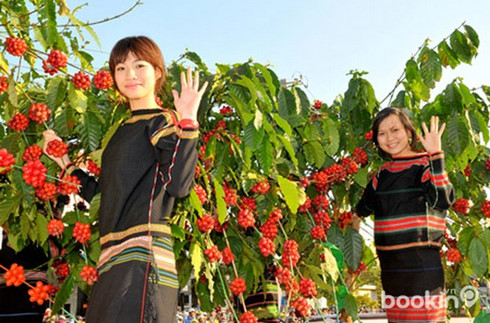The Central Highlands region has long been an attractive destination for foreign visitors by virtue of its beautiful landscapes and the distinct cultures of the local communities.
Introduced to Vietnam in 1857, coffee trees were first grown by the French as a trial in northern Vietnam, before expanding into Tay Nguyen in the Central Highlands region, and on into the southeast.
The Central Highlands region is blessed with fertile basalt-rich earth and a climate that enables coffee plants to thrive. Coffee beans grown here carry a distinct flavour unlike those grown in any other part of the country. The Central Highlands has become famous as the ‘Kingdom of Coffee’, earning Vietnam second place among the world’s top coffee exporters.
The region is home to roughly 570,000 hectares of coffee trees, producing over 1.6 million tonnes annually. Buon Ma Thuot city is dubbed the kingdom of coffee shops in this region.
Coffee shops are everywhere in Buon Ma Thuot. Like iced tea in Hanoi, coffee drinking here is integral to everyday life. Thanks to century-old coffee plantations turning out high coffee yields, Buon Ma Thuot’s coffee is sold in 80 countries and territories worldwide. The most famous line is Robusta coffee which entered the global market through the Trung Nguyen, An Thai, and Cafe Ngon brands.
In a recent years coffee farmers in the Central Highlands, particularly Buon Ma Thuot, have begun growing Arabica coffee, a variety that is increasingly favoured by consumers. Arabica coffee produced in Vietnam has been used by American brand Starbucks in their coffee shops.
Buon Ma Thuot Coffee Association chairman Trinh Duc Minh says that it is the distinct taste and flavour that has made Central Highland’s coffee famous worldwide. The coffee boasts a centuries-long history, from the CADA coffee brand produced during French period to Buon Ma Thuot coffee brands of today.
Buon ma Thuot Coffee Festival was set up to celebrate and promote the coffee drinking culture and introduce the local specialty product to coffee-lovers worldwide.
Gong Festivals of the Central Highlands
To central highlanders, gongs are a valued asset which symbolise wealth and power. The bana, Xedang, Mnong, Coho, Roman, Ede, and Gia Rai ethnic groups of this region all practice the unique and traditional artform of gong playing.
Gong have a close attachment to highlanders’ lives, serving as their spiritual voice and reflecting joys and sorrows in their daily life and work. On festive occasion, lines of people can be seen dancing around fires to the ambient soundtrack of gongs.
Gong playing sits amongst other traditional Vietnamese art forms such as hat xoan (folk songs of northern Phu Tho province), ca tru (ceremonial singing), and nha nhac (royal court music). With the Central Highlands gong performance, however, audiences have the chance to become fully immersed in the whole experience-watching and listening to performances whilst relaxing by an open fire, sipping wine through traditional pipes, and tasting succulent wild roasted meat.
Gong culture is spread across five Central Highlands’ localities including Kon Tum, Gia Lai, Dak Lak, Dak Nong and Lam Dong. Most villages have their own gong ensemble who entertain the highlanders during community practice and festive occasions.
Visitors can take part in a range of interesting programmes such as gongs performance nights, experiencing ethnic minorities’ rituals attached to gongs performances, and a wood statue carving competition with the theme of Central Highlands’ people and culture, amongst others.
It is hoped the festival will contribute to the preservation of the distinct cultural heritage of the highlanders, particularly promoting the gong culture which has been recognising by the United Nations Educational Scientific and Cultural Organisation (UNESCO) as an intangible cultural legacy.
Time-out